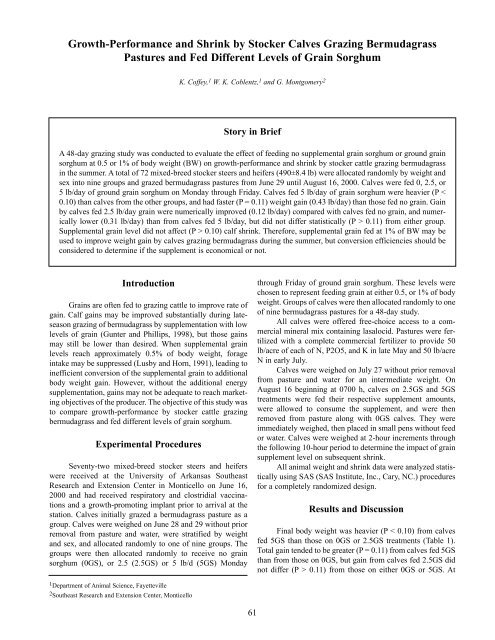Arkansas - Agricultural Communication Services - University of ...
Arkansas - Agricultural Communication Services - University of ...
Arkansas - Agricultural Communication Services - University of ...
You also want an ePaper? Increase the reach of your titles
YUMPU automatically turns print PDFs into web optimized ePapers that Google loves.
Growth-Performance and Shrink by Stocker Calves Grazing Bermudagrass<br />
Pastures and Fed Different Levels <strong>of</strong> Grain Sorghum<br />
K. C<strong>of</strong>fey, 1 W. K. Coblentz, 1 and G. Montgomery 2<br />
Story in Brief<br />
A 48-day grazing study was conducted to evaluate the effect <strong>of</strong> feeding no supplemental grain sorghum or ground grain<br />
sorghum at 0.5 or 1% <strong>of</strong> body weight (BW) on growth-performance and shrink by stocker cattle grazing bermudagrass<br />
in the summer. A total <strong>of</strong> 72 mixed-breed stocker steers and heifers (490±8.4 lb) were allocated randomly by weight and<br />
sex into nine groups and grazed bermudagrass pastures from June 29 until August 16, 2000. Calves were fed 0, 2.5, or<br />
5 lb/day <strong>of</strong> ground grain sorghum on Monday through Friday. Calves fed 5 lb/day <strong>of</strong> grain sorghum were heavier (P <<br />
0.10) than calves from the other groups, and had faster (P = 0.11) weight gain (0.43 lb/day) than those fed no grain. Gain<br />
by calves fed 2.5 lb/day grain were numerically improved (0.12 lb/day) compared with calves fed no grain, and numerically<br />
lower (0.31 lb/day) than from calves fed 5 lb/day, but did not differ statistically (P > 0.11) from either group.<br />
Supplemental grain level did not affect (P > 0.10) calf shrink. Therefore, supplemental grain fed at 1% <strong>of</strong> BW may be<br />
used to improve weight gain by calves grazing bermudagrass during the summer, but conversion efficiencies should be<br />
considered to determine if the supplement is economical or not.<br />
Introduction<br />
Grains are <strong>of</strong>ten fed to grazing cattle to improve rate <strong>of</strong><br />
gain. Calf gains may be improved substantially during lateseason<br />
grazing <strong>of</strong> bermudagrass by supplementation with low<br />
levels <strong>of</strong> grain (Gunter and Phillips, 1998), but those gains<br />
may still be lower than desired. When supplemental grain<br />
levels reach approximately 0.5% <strong>of</strong> body weight, forage<br />
intake may be suppressed (Lusby and Horn, 1991), leading to<br />
inefficient conversion <strong>of</strong> the supplemental grain to additional<br />
body weight gain. However, without the additional energy<br />
supplementation, gains may not be adequate to reach marketing<br />
objectives <strong>of</strong> the producer. The objective <strong>of</strong> this study was<br />
to compare growth-performance by stocker cattle grazing<br />
bermudagrass and fed different levels <strong>of</strong> grain sorghum.<br />
Experimental Procedures<br />
Seventy-two mixed-breed stocker steers and heifers<br />
were received at the <strong>University</strong> <strong>of</strong> <strong>Arkansas</strong> Southeast<br />
Research and Extension Center in Monticello on June 16,<br />
2000 and had received respiratory and clostridial vaccinations<br />
and a growth-promoting implant prior to arrival at the<br />
station. Calves initially grazed a bermudagrass pasture as a<br />
group. Calves were weighed on June 28 and 29 without prior<br />
removal from pasture and water, were stratified by weight<br />
and sex, and allocated randomly to one <strong>of</strong> nine groups. The<br />
groups were then allocated randomly to receive no grain<br />
sorghum (0GS), or 2.5 (2.5GS) or 5 lb/d (5GS) Monday<br />
through Friday <strong>of</strong> ground grain sorghum. These levels were<br />
chosen to represent feeding grain at either 0.5, or 1% <strong>of</strong> body<br />
weight. Groups <strong>of</strong> calves were then allocated randomly to one<br />
<strong>of</strong> nine bermudagrass pastures for a 48-day study.<br />
All calves were <strong>of</strong>fered free-choice access to a commercial<br />
mineral mix containing lasalocid. Pastures were fertilized<br />
with a complete commercial fertilizer to provide 50<br />
lb/acre <strong>of</strong> each <strong>of</strong> N, P2O5, and K in late May and 50 lb/acre<br />
N in early July.<br />
Calves were weighed on July 27 without prior removal<br />
from pasture and water for an intermediate weight. On<br />
August 16 beginning at 0700 h, calves on 2.5GS and 5GS<br />
treatments were fed their respective supplement amounts,<br />
were allowed to consume the supplement, and were then<br />
removed from pasture along with 0GS calves. They were<br />
immediately weighed, then placed in small pens without feed<br />
or water. Calves were weighed at 2-hour increments through<br />
the following 10-hour period to determine the impact <strong>of</strong> grain<br />
supplement level on subsequent shrink.<br />
All animal weight and shrink data were analyzed statistically<br />
using SAS (SAS Institute, Inc., Cary, NC.) procedures<br />
for a completely randomized design.<br />
Results and Discussion<br />
Final body weight was heavier (P < 0.10) from calves<br />
fed 5GS than those on 0GS or 2.5GS treatments (Table 1).<br />
Total gain tended to be greater (P = 0.11) from calves fed 5GS<br />
than from those on 0GS, but gain from calves fed 2.5GS did<br />
not differ (P > 0.11) from those on either 0GS or 5GS. At<br />
1 Department <strong>of</strong> Animal Science, Fayetteville<br />
2 Southeast Research and Extension Center, Monticello<br />
61

















